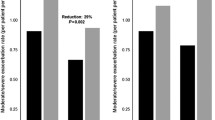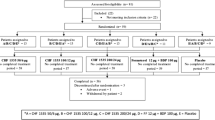Abstract
Background and objectives
Foster™ is a fixed combination of beclometasone dipropionate/formoterol (BDP/F). It is formulated as an extra-fine solution and delivered via a pressurized metered-dose inhaler (pMDI) using a hydrofluoroalkane (HFA) propellant. The aims of this study were to compare the systemic exposure to BDP, to its active metabolite beclometasone-17-monopropionate (B17MP) and to formoterol after administration of BDP/F versus separate administration of a chlorofluorocarbon (CFC) formulation of BDP and formoterol HFA, and to explore a possible relationship between pharmacokinetic and pharmacodynamic findings.
Methods
In this open-label, crossover, placebo-controlled study, 12 healthy male subjects received a single dose of BDP/F 400 µg/24 µg (four inhalations of Foster™ BDP/F 100 µg/6 µg), single doses of BDP CFC 1000 µg (four inhalations of Becotide™ Forte 250 µg) plus formoterol 24 µg (four inhalations of Atimos® 6 µg) via separate MDIs, or placebo. Continuous pharmacokinetic variables for BDP, B17MP, formoterol, cortisol and potassium were evaluated. Cardiovascular effects, peak flow measurements and tolerability were also examined.
Results
Exposure to BDP was not significantly different between active treatment arms, but lower systemic exposure to B17MP was observed with the fixed combination than with the separate components (area under the plasma concentration-time curve [AUC] from time zero to infinity [AUC∞] 5280 vs 8120pg · h/mL; p = 0.001). Despite a lower total systemic exposure to B17MP with the fixed combination, B17MP plasma concentrations during the first 30 minutes after administration, indicative of pulmonary absorption, were 86% higher with BDP/F than with the separate components (AUC from 0 to 30 minutes [AUC30 min] 353 vs 190pg · h/mL; p = 0.003). Twenty-four-hour serum cortisol concentrations were significantly higher with BDP/F than with BDP and formoterol administered separately (2.26 vs 1.90 µg · h/mL; p < 0.01). No significant differences in the pharmacokinetic parameters of formoterol and no clinically relevant differences in serum potassium and cardiovascular or spirometric parameters were observed between the treatments. Both active treatments were well tolerated.
Conclusion
These pharmacokinetic data show that with a BDP dose from Foster™ that is 2.5 times less than a BDP dose from Becotide™ Forte, pulmonary absorption is 86% higher; however, systemic exposure is 35% lower, resulting in less cortisol suppression for a similar BDP dosage.










Similar content being viewed by others
Notes
Foster™ is marketed as Fostair® or Innovair® in some European countries.
References
US National Institutes of Health [NIH]. Pharmacologic therapy: the medications. In: Guidelines for the diagnosis and management of asthma [NIH publication no. 97-4051]. Bethesda (MD): NIH, 1997: 59–79
Bateman ED, Bantje TA, Joao Gomes M, et al. Combination therapy with single inhaler budesonide/formoterol compared with high dose of fluticasone propionate alone in patients with moderate persistent asthma. Am J Respir Med 2003; 2(3): 275–81
Lalloo UG, Malolepszy J, Kozma D, et al. Budesonide and formoterol in a single inhaler improves asthma control compared with increasing the dose of corticosteroid in adults with mild-to-moderate asthma. Chest 2003 May; 123(5): 1480–7
Pauwels RA, Lofdahl CG, Postma DS, et al. Effect of inhaled formoterol and budesonide on exacerbations of asthma. Formoterol and Corticosteroids Establishing Therapy (FACET) International Study Group. N Engl J Med 1997 Nov 13; 337(20): 1405–11
Ringdal N, Chuchalin A, Chovan L, et al. Evaluation of different inhaled combination therapies (EDICT): a randomised, double–blind comparison of Seretide (50/250 microg bd Diskus vs formoterol (12 microg bd) and budesonide (800 microg bd) given concurrently (both via Turbuhaler) in patients with moderate–to–severe asthma. Respir Med 2002 Nov; 96(11): 851
Tal A, Simon G, Vermeulen JH, et al. Budesonide/formoterol in a single inhaler versus inhaled corticosteroids alone in the treatment of asthma. Pediatr Pulmonol 2002; 34(5): 342–50
Bateman ED, Hurd SS, Barnes PJ, et al. Global strategy for asthma management and prevention: GINA executive summary. Eur Respir J 2008 Jan; 31(1): 143–78
Acerbi D, Brambilla G, Kottakis I. Advances in asthma and COPD management: delivering CFC-free inhaled therapy using Modulite technology. Pulm Pharmacol Ther 2007; 20(3): 290–303
British National Formulary Joint Formulary Committee. British national formulary. 56th ed. London: British Medical Association and Royal Pharmaceutical Society of Great Britain, 2008
Papi A, Paggiaro PL, Nicolini G, et al. Beclomethasone/formoterol versus budesonide/formoterol combination therapy in asthma. Eur Respir J 2007 Apr; 29(4): 682–9
Papi A, Paggiaro P, Nicolini G, et al. Beclomethasone/formoterol versus fluticasone/salmeterol inhaled combination in moderate to severe asthma. Allergy 2007; 62(10): 1182–8
Trinity-Chiesi Pharmaceuticals Ltd. Fostair®: summary of product characteristics. Cheadle: Trinity-Chiesi Pharmaceuticals Ltd, 2007
TEVA Specialty Pharmaceuticals. QVAR®: summary of product characteristics. Philadelphia (PA): TEVA Specialty Pharmaceuticals, 2006
Magnussen H. Equivalent asthma control after dose reduction with HFA-134a beclomethasone solution aerosol. Comparative Inhaled Steroid Investigation Group (CISIG). Respir Med 2000 Jun; 94(6): 549–55
Vanden Burgt JA, Busse WW, Martin RJ, et al. Efficacy and safety overview of a new inhaled corticosteroid, QVAR (hydrofluoroalkane-beclomethasone extrafine inhalation aerosol), in asthma. J Allergy Clin Immunol 2000 Dec; 106(6): 1209–26
Rigamonti E, Kottakis I, Pelc M, et al. Comparison of a new extrafine beclometasone dipropionate HFA 134a-formulated pMDI with a standard BDP CFC pMDI in adults with moderate persistent asthma. Eur Respir J 2006; 28 Suppl. 50: 206–7
Busse WW, Brazinsky S, Jacobson K, et al. Efficacy response of inhaled beclomethasone dipropionate in asthma is proportional to dose and is improved by formulation with a new propellant. J Allergy Clin Immunol 1999; 104: 1215–22
Davies RJ, Stampone P, O’Connor BJ. Hydrofluoroalkane-134a beclomethasone dipropionate extrafine aerosol provides equivalent asthma control to chlorofluorocarbon beclomethasone dipropionate at approximately half the total daily dose. Respir Med 1998 Jun; 92 Suppl. A: 23–31
Leach CL, Davidson PJ, Hasselquist BE, et al. Lung deposition of hydrofluoroalkane-134a beclomethasone is greater than that of chlorofluorocarbon fluticasone and chlorofluorocarbon beclomethasone: a cross-over study in healthy volunteers. Chest 2002; 122: 510–6
Harrison LI, Soria I, Cline AC, et al. Pharmacokinetic differences between chlorofluorocarbon and chlorofluorocarbon-free metered dose inhalers of beclomethasone dipropionate in adult asthmatics. J Pharm Pharmacol 1999; 51: 1235–40
Harrison LI, Colice GL, Donnell D, et al. Adrenal effects and pharmacokinetics of CFC-free beclomethasone dipropionate: a 14-day dose-response study. J Pharm Pharmacol 1999; 51: 263–9
Mariotti F, Poli G, Acerbi D, et al. Lung deposition of BDP/formoterol HFA PMDI in healthy subjects, asthmatic and COPD patients [abstract]. 2008 Annual Congress, European Respiratory Society; 2008 Oct 4–8; Berlin
Häussermann S, Acerbi D, Brand P, et al. Lung deposition of formoterol HFA (Atimos®/Forair®) in healthy volunteers, asthmatic and COPD patients. J Aerosol Med 2007; 20: 331–41
World Medical Association [WMA]. Declaration of Helsinki, amended by the 52nd WMA General Assembly, Edinburgh, Scotland, October 2000. Ferney-Voltaire: WMA, 2000
International Conference on Harmonisation of Technical Requirements for Registration of Pharmaceuticals for Human Use [ICH]. Note for guidance on good clinical practice (CPMP/ICH/135/95) [online]. Available from URL: http://www.emea.europa.eu/htms/human/ich/background.htm [Accessed 2008 Dec 9]
Organisation for Economic Co-operation and Development [OECD]. OECD principles on good laboratory practice [report no. ENV/MC/CHEM (98) 17]. Paris: OECD Environment Directorate, 1998
Lewis D, Brambilla G, Church T, et al. BDP and formoterol association within a combination HFA solution MDI. Respiratory Drug Delivery X 2006; 3: 939–42
Theophilus A, Moore A, Prime D, et al. Co-deposition of salmeterol and fluticasone propionate by a combination inhaler. Int J Pharm 2006; 313: 14–22
Nelson HS, Chapman KR, Pyke SD, et al. Enhanced synergy between fluticasone propionate and salmeterol inhaled from a single inhaler versus separate inhalers. J Allergy Clin Immunol 2003 Jul; 112(1): 29–36
Huchon G, Magnussen H, Chuchalin A, et al. Lung function and asthma control with beclomethasone and formoterol in a single inhaler. Respir Med 2009 Jan; 103(1): 41–9
Daley-Yates PT, Price AC, Sisson JR, et al. Beclomethasone dipropionate: absolute bioavailability, pharmacokinetics and metabolism following intravenous, oral, intranasal and inhaled administration in man. Br J Clin Pharmacol 2001 May; 51(5): 400–9
Derendorf H. Pharmacokinetic and pharmacodynamic properties of inhaled corticosteroids in relation to efficacy and safety. Respir Med 1997 Nov; 91 Suppl. A: 22–8
Silkstone VL, Corlett SA, Chrystyn H. Determination of the relative bioavailability of salbutamol to the lungs and systemic circulation following nebulization. Br J Clin Pharmacol 2002 Aug; 54(2): 115–9
Chrystyn H. Methods to identify drug deposition in the lungs following inhalation. Br J Clin Pharmacol 2001 Apr; 51(4): 289–99
Poli G, Acerbi D, Rusca A. Pharmacokinetics and lung bioavailability of Foster® using the standard actuator or a spacer [abstract]. Eur Respir J 2007; 30 Suppl. 51: 350
Esposito-Festen JE, Zanen P, Tiddens HA, et al. Pharmacokinetics of inhaled monodisperse beclomethasone as a function of particle size. Br J Clin Pharmacol 2007 Sep; 64(3): 328–34
Piccinno A, Poli G, Acerbi D, et al. Pharmacokinetics and pharmacodynamics of a new beclomethasone dipropionate and formoterol CFC-free fixed combination in healthy volunteers. Respiratory Drug Delivery Europe 2007; 1: 267–70
Kelly HW, Nelson HS. Potential adverse effects of the inhaled corticosteroids. J Allergy Clin Immunol 2003 Sep; 112(3): 469–78
Derendorf H, Nave R, Drollmann F, et al. Relevance of pharmacokinetics and pharmacodynamics of inhaled corticosteroids to asthma. Eur Resp J 2006; 28: 142–1050
Singh D, Piccinno A, Borrill Z, et al. Tolerability of high cumulative dose of HFA modulite beclomethasone dipropionate/formoterol combination inhaler in asthmatic patients. Pulm Pharmacol Therap 2008; 21(3): 551–7
Lipworth B. Risk versus benefits of inhaled beta 2 agonists in the management of asthma. Drug Saf 1992; 7: 54–70
Acknowledgements
This study was sponsored by Chiesi Farmaceutici SpA. Medical writing assistance for the preparation of this manuscript was provided by Wolters Kluwer Health Medical Communications. This assistance was funded by Chiesi Farmaceutici SpA. J. Bousquet has received honoraria from Chiesi for lectures and advisory boards. G. Poli, D. Acerbi and R. Monno are employees of Chiesi Farmaceutici SpA. S. Ramael and F. Nollevaux are employees of SGS Life Sciences Services. The authors acknowledge Dr Carmen Dell’Anna for her scientific contribution to this manuscript.
Author information
Authors and Affiliations
Corresponding author
Rights and permissions
About this article
Cite this article
Bousquet, J., Poli, G., Acerbi, D. et al. Systemic Exposure and Implications for Lung Deposition with an Extra-Fine Hydrofluoroalkane Beclometasone Dipropionate/Formoterol Fixed Combination. Clin Pharmacokinet 48, 347–358 (2009). https://doi.org/10.2165/00003088-200948060-00001
Published:
Issue Date:
DOI: https://doi.org/10.2165/00003088-200948060-00001




